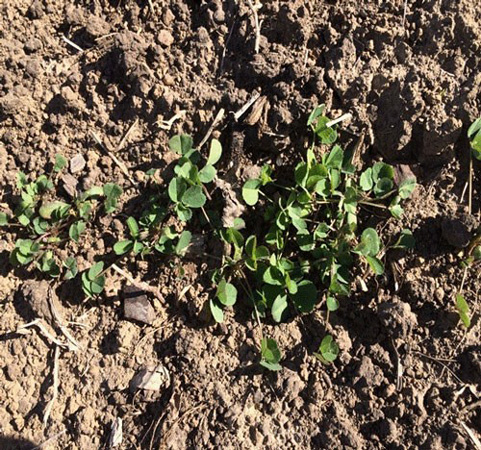In 2024, approximately 585,000 acres of alfalfa were harvested in Kansas, which supports the dairy and livestock industry. Alfalfa hayfields help to supply forage that is highly digestible and high in protein due to being a leguminous crop. Late summer and early fall are often the best alfalfa planting windows for Kansas due to less weed pressure than spring planting, though there are some challenges.
Available moisture at planting is crucial for alfalfa establishment, but too much moisture can increase seedling disease incidence and reduce alfalfa nodulation and nitrogen fixation.
If soil moisture is available, northwest Kansas growers can plant as early as August 10. The optimum sowing date occurs later as we move towards southeast Kansas, where growers can plant until mid- to late-September. In other parts of Kansas, the optimal planting time is late August or early September, as we need to plant early enough to have three to five trifoliate leaves before the first frost (Figure 1).

Figure 1. Alfalfa seedlings. Photo by Doohong Min, K-State Research and Extension.
Alfalfa is a four to five-year, or longer, investment, and therefore it is crucial to ensure proper establishment. Some producers shy away from alfalfa because of its high establishment cost and risk of stand failure. In the long run, however, it’s relatively inexpensive if recouped over the life of the crop.
Dryland alfalfa can produce 3 to 6 dry matter tons of forage per acre per year in well-managed conditions and favorable weather patterns. Irrigated fields can produce 6 to 8 dry matter tons per acre per year or more. Forage quality and tonnage depend on cutting frequency, percent bloom, and overall management of the crop (fertility, weeds, insects, etc.).
When sowing alfalfa, producers should keep the following in mind:
Soil test and correct soil acidity. Alfalfa grows best in well-drained soils with a pH of 6.5 to 7.5 and does not tolerate low soil pH. If the soil is acidic, add lime to raise soil pH to 6.8 before planting. Ensuring appropriate soil pH levels before planting is essential, especially as lime is relatively immobile in the soil profile and the field will not be worked for the next 3-5 years. Remember, after spreading, lime takes a few weeks or more in the soil to react and increase the pH.
Soil test and meet fertilization needs. Apply the needed phosphorus (P) and potassium (K) amounts according to soil test recommendations. Phosphorus fertilizer will be required if soil test P levels are below 25 ppm, and potassium fertilizer will be required if soil K levels are below 120 ppm. Depending on yield goals, soils that test higher than these thresholds may also need additional fertilizer. Small amounts of nitrogen fertilizer (15 to 20 lb/acre) as a starter at planting are beneficial for alfalfa establishment. In some fields, in particular those with sandier texture and low organic matter content, sulfur can also bring some yield benefits.
Plant certified, inoculated seed. Ensuring the correct Rhizobium inoculation is crucial for alfalfa seedlings to fix available soil nitrogen to meet the needs of growing alfalfa for optimum production. This inoculation is not the same as other legumes, such as soybeans and clovers.
Plant in firm, moist soil. A firm seedbed ensures good seed-soil contact; therefore, use a press wheel with the drill to firm the soil over the planted seed. No-till planting in small-grains stubble will usually provide a good seedbed.
Plant no deeper than 10 times the seed diameter. Don’t plant too deeply. Plant one-fourth to one-half inch deep on medium- and fine-textured soils and three-fourths inch deep on sandy soils.
Use the right seeding rate. Plant 8 to 12 pounds of seed per acre on dryland in western Kansas, 12 to 15 pounds per acre on irrigated medium- to fine-textured soils, 15 to 20 pounds per acre on irrigated sandy soils, and 12 to 15 pounds per acre on dryland in central and eastern Kansas.
Check for herbicide carryover that could damage the new alfalfa crop. This is especially true when planting alfalfa no-till into corn or grain sorghum stubble. In areas where row crops were drought-stressed and removed for silage, that sets up a great seedbed for alfalfa, but may still bring a risk of herbicide damage.
Choose pest-resistant varieties. Resistance to phytophthora root rot, bacterial wilt, fusarium wilt, verticillium wilt, anthracnose, the pea aphid, and the spotted alfalfa aphid is essential. Some varieties are resistant to even more diseases and insects, which could contribute to reducing costs.
Purchase alfalfa varieties with a fall dormancy rating ranging from 4 - 6 for Kansas. Fall dormancy relates to how soon an alfalfa variety will stop growing in the fall and how early it will begin growing in the spring or late winter. Simply put, it would be better not to buy a variety with fall dormancy of 9-10, which can be more suitable for California and regions where alfalfa can keep growing year-round under irrigation and warmer winter conditions.
More information about growing alfalfa in Kansas can be found in the Alfalfa Production Handbook. That information is also available on the web at: www.ksre.ksu.edu/bookstore/pubs/c683.pdf
Also see Alfalfa Growth and Development, available on the web at: https://www.bookstore.ksre.ksu.edu/pubs/MF3348.pdf
Romulo Lollato, Wheat and Forages Specialist
lollato@ksu.edu
Doohong Min, Forage Management
dmin@ksu.edu
Tina Sullivan, Northeast Area Agronomist
tsullivan@ksu.edu